| کد مقاله | کد نشریه | سال انتشار | مقاله انگلیسی | نسخه تمام متن |
|---|---|---|---|---|
| 2928637 | 1576142 | 2016 | 6 صفحه PDF | دانلود رایگان |

BackgroundRandomized clinical trials on bioresorbable scaffolds (BRS) enrolled patients with simple coronary lesions. The present study was sought to give preliminary findings about safety of BRS implantation in overlap in long coronary lesions.MethodsFrom June 2012 to January 2015, we prospectively collected data from 162 consecutive patients receiving overlapping BRS implantation in the 16 participating institutions. We applied a propensity-score to match BRS-treated patients with 162 patients receiving second generation drug eluting stents (DES) in overlap. The primary endpoint was a device-oriented endpoint (DOCE), including cardiac death, target vessel myocardial infarction, and target lesion revascularization.ResultsDOCE rate did not significantly differ between the two groups (5.6% in BRS group vs. 7.4% in DES group, HR 0.79, 95%CI 0.37–3.55, p = 0.6). Also stent/scaffold thrombosis did not differ between groups (1.2% in BRS group vs. 1.9% in DES group, p = 0.6). Occurrence of procedural-related myocardial injury was significantly higher in the BRS group (25% vs. 12%, p = 0.001), although it was not related to DOCE (HR 1.1, 95%CI 0.97–1.2, p = 0.2). Imaging techniques and enhanced stent visualization systems were significantly more employed in the BRS group (p = 0.0001 for both). Procedure length, fluoroscopy time and contrast dye amount were significantly higher in the BRS group (p = 0.001, p = 0.001 and p = 0.01, respectively).ConclusionsOverlapping BRS utilization in long coronary lesions showed a comparable DOCE rate at 1 year if compared to second generation DES. Further and larger studies are on demand to confirm our findings.
Journal: International Journal of Cardiology - Volume 208, 1 April 2016, Pages 40–45